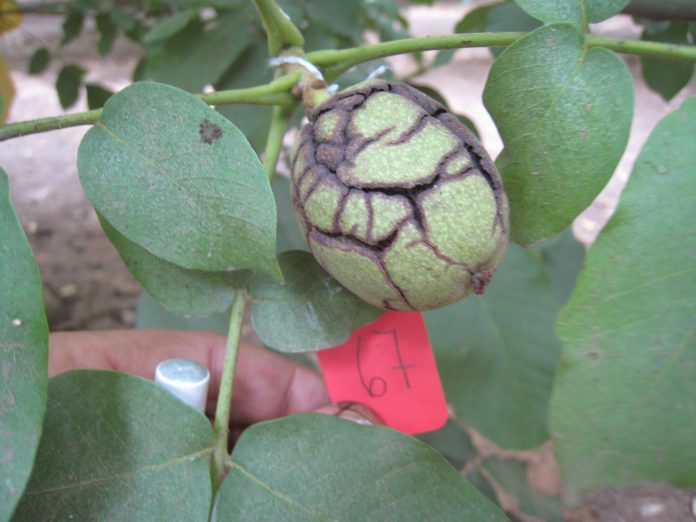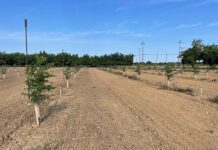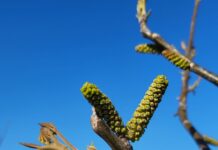
In a tough price year, walnut quality becomes paramount for growers. Large, light-colored kernels free from insect damage and mold garner the best returns, but in 2022, the ideal was elusive for many walnut growers.
At the 51st annual Tri-County Walnut Day held in Tulare, Calif., UC researcher Bruce Lampinen said that with increasing temperatures and uncertain water availability, walnut quality is going to be an increasing problem for growers, particularly in the southern San Joaquin Valley, but statewide as well.
Overirrigation or underirrigation, walnut husk fly, navel orangeworm, blight, Botryosphaeria (Bot) and Phomopsis are all known to have negative impacts on kernel quality. In 2022, it became evident that excessive daytime temperatures at critical walnut development stages can also impact walnut quality.
Lampinen said walnut quality has been decreasing in recent years with blocks of higher-value varieties Howard, Tulare and Chandler delivering higher percentages of dark kernels. In-shell weights, indicative of kernel percentage and/or nut size, have also been decreasing. Lampinen as well as other researchers, growers and walnut industry leaders said environmental causes, specifically high temperatures at critical stages of nut development, are causing quality issues. With the 2022 harvest, damage was widespread. He said many nuts had damaged hulls on one side likely due to the September heat spell. Since the nuts were already at ambient air temperatures of 111 degrees F and higher, any nut in the sun at the warmest time of day in early afternoon could have reached 122 degrees F, the temperature at which pellicle damage occurs.
Quality Impacted by Heat
Joe Grant, California Walnut Board director of research, said water stress, low carbohydrate levels and sunburn all impact walnut quality, but 2022 was a particularly bad year due to high heat in early-September.
“About two to three weeks earlier than normal hull split starts, the hulls of some nuts, usually in low and interior canopy positions, develop a ‘shattered glass’ appearance. Then they turned black and adhered to the shell,” Grant said.
Lampinen in his presentation said nuts that have hulls that do not split normally maintain wet conditions around the kernel and cause it to darken.
Willows walnut grower Leslie Nerli said at first she thought the unusual hull appearance was due to latent blight. There was no pattern to the damage, but she said it became obvious after a heat spell in early September.
She said nut samples were sent to Plant Pathologist Themis Michailides at the UC Kearney research center to determine the cause of the blackened hulls.
Michailides said Nerli was not the only walnut grower to contact him with concerns.
“I received a lot of requests to come to the orchards and look at this problem, and my first impression looking at the nuts is that when opened, they looked ‘cooked’,” he said.
Pathogens Secondary to Heat Damage
To determine exact cause of the blackened, adhering hulls, Michailides said samples showed high levels of pathogens, including Alternaria, Fusarium, aspergillus niger and Botryosphaeria, but he believed those pathogens were secondary to the heat damage. As the affected hulls deteriorated, he said the hull tissue was killed and the pathogens moved in fast to colonize the dead tissue.
Some inside kernel mold was also found in the samples. He reported in Sac Valley Walnut News that the high mold incidence was worsened by the rainfall following the heat wave. The hull rot also stopped the hull split process, causing the black hulls at harvest, dark kernels and high huller and processor rejection levels. Michailides said the high heat occurred when the oil in the kernel was most susceptible to damage.
Nerli said Michailides came to her orchard and took nut samples back to the lab for testing. Her 2006 planted Chandler block had three previous years of at least 92% light, and total mold was never above 2%, nor was total serious for the final grade average above 2%. Last year, she said for that block, the average light count was 64% with a mold count of 4% and a serious average of 5%.
Nerli said besides the 2006 planting, she has blocks planted in 2012 and 2018. Spacings are the same in all three blocks. They are sprinkler-irrigated, and a pressure bomb is used to determine irrigation timing.
She said the trees were sprayed with Surround, and Bot, Alternaria and blight spray treatments were done, but these didn’t improve the black hull situation.
“With the grades we have from both sunburn and the black nuts under the canopy that I believe worsened over the summer with the high heats, coming on at different times within a single orchard from July through September, it will be tough to market. Yields were up, but quality was a disaster.”
Lampinen said he has previously conducted field trials involved tagging and monitoring of individual nuts on the tree to assess environmental and canopy position impacts on quality. Lampinen said light was measured over the course of the day and leaves were sampled to assess leaf specific mass. Leaf area and in-shell and kernel weights were measured at the time of harvest. Low leaf specific mass is a result of low light conditions, and results in kernel quality problems, he said, and spurs that have lost leaves tend to have nuts with discolored hulls.
“Timing of stress has different impacts on the crop. Stress during May to June impacts nut size. Stress during July and August, when kernels fill, can impact size and cause shrivel. Stress from late August to hull split in September cause dark kernels,” he said.
The trial also included a look at four degrees of hull split or lack of hull split. The black and shattered nuts generally are in the lower canopy he said and are normally related to insufficient light and leaf area and generally only impact 5% or less of the nuts on the tree. Lampinen said that much of the 2022 quality problems were likely caused by other factors. One factor is overirrigation as Lampinen reported seeing more severe black nut damage in wetter orchards.
The trials also showed that most sunburn occurred in the lower positions on the southwest side of the tree where there was an indentation in the canopy, likely leading to lack of air circulation. Since sunburn has historically been known as a cause for diminished walnut quality, Lampinen said numerous trials have looked at use of kaolin clay products applied by sprayer. Kaolin products should be used, he said, if beneficial for pest management or sunburn, but it will not reduce water stress. Kaolin coverage needs to be concentrated on nuts that are in the sun from 1 p.m. to 2 p.m.
Lampinen said trials also showed that kaolin treated trees were more stressed that untreated trees, most likely because stomata stayed open on the cooler kaolin treated leaves longer, resulting in more stress.
Citing numerous walnut quality studies done over the years, Lampinen said that kaolin treatments are unlikely to have much beneficial impact in years like 2022. Growers who plan to use kaolin should walk through the orchard from 1 p.m. to 2 p.m. Nuts that are in the sun at that time should be targeted for the treatment.
Lampinen said adequate soil moisture is important, but orchards should not be excessively wet approaching harvest. Do not, he warned, apply a big irrigation right before a severe heat event.











